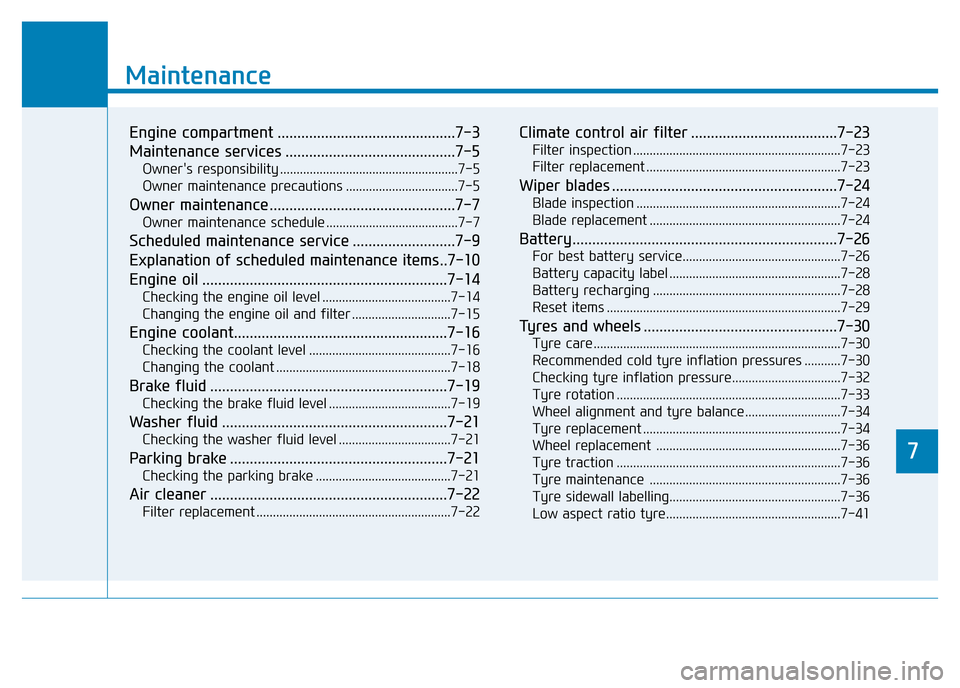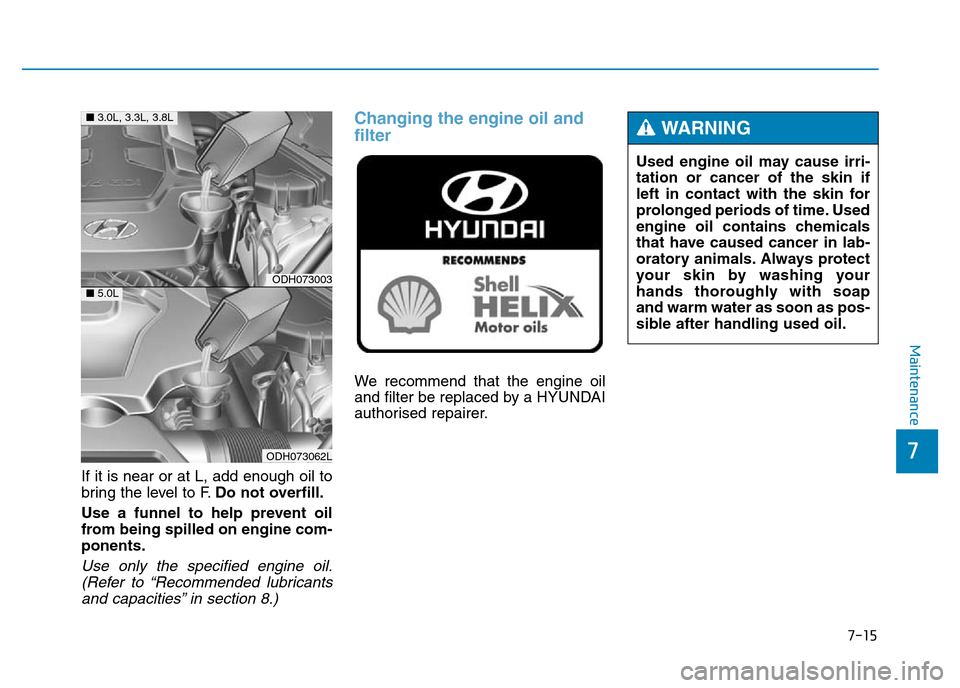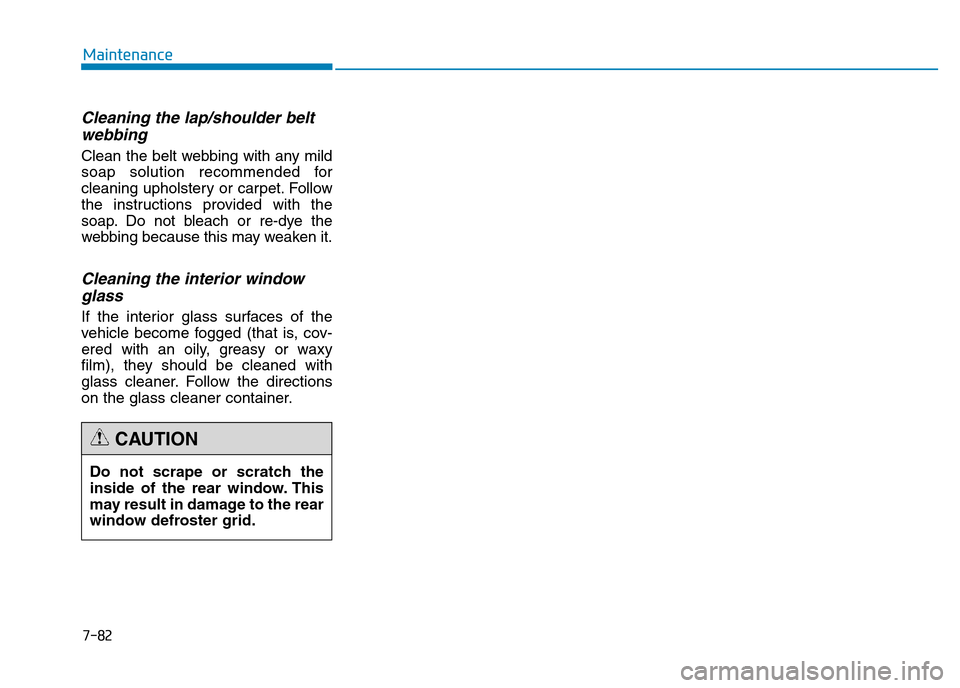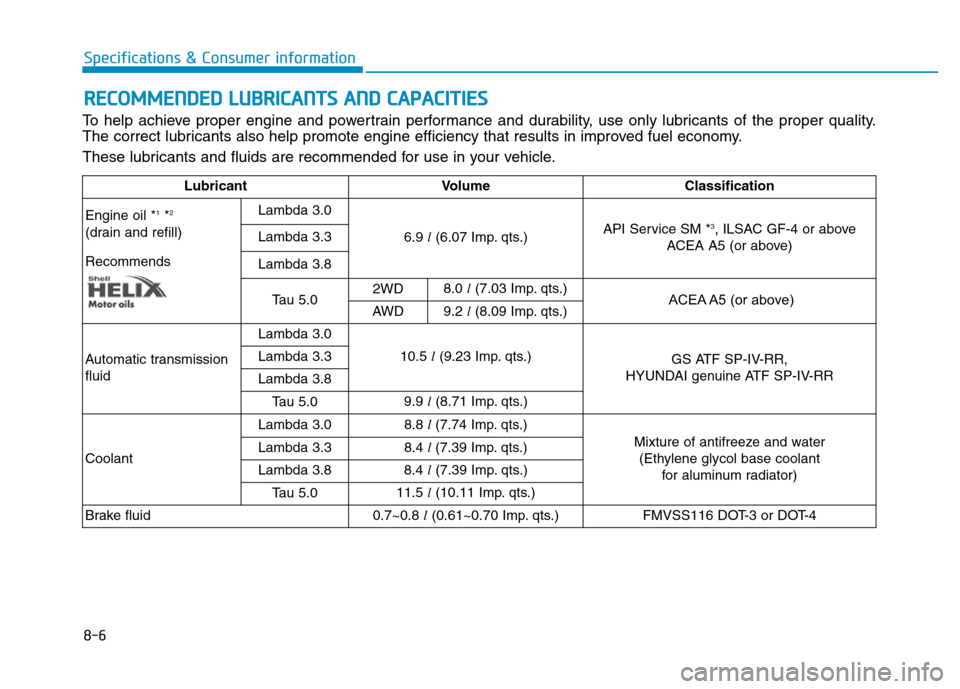2016 Hyundai Genesis recommended oil
[x] Cancel search: recommended oilPage 370 of 502

5-97
Driving your vehicle
Winter precaution
Use high quality ethylene glycol
coolant
Your vehicle is delivered with high
quality ethylene glycol coolant in the
cooling system. It is the only type of
coolant that should be used because
it helps prevent corrosion in the cool-
ing system, lubricates the water
pump and prevents freezing. Be sure
to replace or replenish your coolant
in accordance with the maintenance
schedule in section 7. Before winter,
have your coolant tested to assure
that its freezing point is sufficient for
the temperatures anticipated during
the winter.
Check battery and cables
Winter puts additional burdens on
the battery system. Visually inspect
the battery and cables as described
in section 7. We recommend that the
level of charge in your battery be
checked by a HYUNDAI authorised
repairer.
Change to "winter weight" oil if
necessary
In some climates it is recommended
that a lower viscosity "winter weight"
oil be used during cold weather. See
section 8 for recommendations. If
you aren't sure what weight oil you
should use, we recommend that you
consult a HYUNDAI authorised
repairer.
Check spark plugs and ignition
system
Inspect your spark plugs as
described in section 7 and replace
them if necessary. Also check all
ignition wiring and components to be
sure they are not cracked, worn or
damaged in any way.
To keep locks from freezing
To keep the locks from freezing,
squirt an approved de-icer fluid or
glycerine into the key opening. If a
lock is covered with ice, squirt it with
an approved de-icing fluid to remove
the ice. If the lock is frozen internally,
you may be able to thaw it out by
using a heated key. Handle the heat-
ed key with care to avoid injury.
Use approved window washer
anti-freeze in system
To keep the water in the window
washer system from freezing, add an
approved window washer anti-freeze
solution in accordance with instruc-
tions on the container. Window wash-
er anti-freeze is available from a
HYUNDAI authorised repairer and
most auto parts outlets. Do not use
engine coolant or other types of anti-
freeze as these may damage the
paint finish.5
Page 407 of 502

7
Maintenance
7
Maintenance
Engine compartment .............................................7-3
Maintenance services ...........................................7-5
Owner's responsibility ......................................................7-5
Owner maintenance precautions ..................................7-5
Owner maintenance ...............................................7-7
Owner maintenance schedule ........................................7-7
Scheduled maintenance service ..........................7-9
Explanation of scheduled maintenance items..7-10
Engine oil ..............................................................7-14
Checking the engine oil level .......................................7-14
Changing the engine oil and filter ..............................7-15
Engine coolant......................................................7-16
Checking the coolant level ...........................................7-16
Changing the coolant .....................................................7-18
Brake fluid ............................................................7-19
Checking the brake fluid level .....................................7-19
Washer fluid .........................................................7-21
Checking the washer fluid level ..................................7-21
Parking brake .......................................................7-21
Checking the parking brake .........................................7-21
Air cleaner ............................................................7-22
Filter replacement ...........................................................7-22
Climate control air filter .....................................7-23
Filter inspection ...............................................................7-23
Filter replacement ...........................................................7-23
Wiper blades .........................................................7-24
Blade inspection ..............................................................7-24
Blade replacement ..........................................................7-24
Battery...................................................................7-26
For best battery service................................................7-26
Battery capacity label ....................................................7-28
Battery recharging .........................................................7-28
Reset items .......................................................................7-29
Tyres and wheels .................................................7-30
Tyre care ...........................................................................7-30
Recommended cold tyre inflation pressures ...........7-30
Checking tyre inflation pressure.................................7-32
Tyre rotation ....................................................................7-33
Wheel alignment and tyre balance.............................7-34
Tyre replacement ............................................................7-34
Wheel replacement ........................................................7-36
Tyre traction ....................................................................7-36
Tyre maintenance ..........................................................7-36
Tyre sidewall labelling....................................................7-36
Low aspect ratio tyre.....................................................7-41
7
Page 421 of 502

7-15
7
Maintenance
If it is near or at L, add enough oil to
bring the level to F.Do not overfill.
Use a funnel to help prevent oil
from being spilled on engine com-
ponents.
Use only the specified engine oil.
(Refer to “Recommended lubricants
and capacities” in section 8.)
Changing the engine oil and
filter
We recommend that the engine oil
and filter be replaced by a HYUNDAI
authorised repairer.
ODH073003
ODH073062L
■3.0L, 3.3L, 3.8L
■5.0L
Used engine oil may cause irri-
tation or cancer of the skin if
left in contact with the skin for
prolonged periods of time. Used
engine oil contains chemicals
that have caused cancer in lab-
oratory animals. Always protect
your skin by washing your
hands thoroughly with soap
and warm water as soon as pos-
sible after handling used oil.
WARNING
Page 487 of 502

7-81
7
Maintenance
Interior care
Interior general precautions
Prevent chemicals such as perfume,
cosmetic oil, sun cream, hand clean-
er and air freshener from contacting
the interior parts because they may
cause damage or discolouration. If
they do contact the interior parts,
wipe them off immediately.
See the instructions that follow for
the proper way to clean vinyl.
Cleaning the upholstery and
interior trim
Vinyl
Remove dust and loose dirt from
vinyl with a whisk broom or vacuum
cleaner. Clean vinyl surfaces with a
vinyl cleaner.
Fabric
Remove dust and loose dirt from fab-
ric with a whisk broom or vacuum
cleaner. Clean with a mild soap solu-
tion recommended for upholstery or
carpets. Remove fresh spots imme-
diately with a fabric spot cleaner. If
fresh spots do not receive immediate
attention, the fabric can be stained
and its colour can be affected. Also,
its fire-resistant properties can be
reduced if the material is not proper-
ly maintained. Never allow water or other liq-
uids to come in contact with
electrical/electronic compo-
nents inside the vehicle as this
may damage them.
CAUTION
When cleaning leather products
(steering wheel, seats etc.), use
neutral detergents or low alco-
hol content solutions. If you use
high alcohol content solutions
or acid/alkaline detergents, the
colour of the leather may fade
or the surface may get stripped
off.
CAUTION
Using anything but recom-
mended cleaners and proce-
dures may affect the fabric’s
appearance and fire-resistant
properties.
CAUTION
Page 488 of 502

7-82
Maintenance
Cleaning the lap/shoulder belt
webbing
Clean the belt webbing with any mild
soap solution recommended for
cleaning upholstery or carpet. Follow
the instructions provided with the
soap. Do not bleach or re-dye the
webbing because this may weaken it.
Cleaning the interior window
glass
If the interior glass surfaces of the
vehicle become fogged (that is, cov-
ered with an oily, greasy or waxy
film), they should be cleaned with
glass cleaner. Follow the directions
on the glass cleaner container.
Do not scrape or scratch the
inside of the rear window. This
may result in damage to the rear
window defroster grid.
CAUTION
Page 497 of 502

8-6
Specifications & Consumer information
RECOMMENDED LUBRICANTS AND CAPACITIES
To help achieve proper engine and powertrain performance and durability, use only lubricants of the proper quality.
The correct lubricants also help promote engine efficiency that results in improved fuel economy.
These lubricants and fluids are recommended for use in your vehicle.
LubricantVolume Classification
Engine oil *
1*2
(drain and refill)
RecommendsLambda 3.06.9l(6.07 Imp. qts.)API Service SM *3, ILSAC GF-4 or above
ACEA A5 (or above) Lambda 3.3
Lambda 3.8
Tau 5.02WD8.0l(7.03 Imp. qts.)ACEA A5 (or above)AWD9.2l(8.09 Imp. qts.)
Automatic transmission
fluidLambda 3.0
10.5l(9.23 Imp. qts.)
GS ATF SP-IV-RR,
HYUNDAI genuine ATF SP-IV-RR Lambda 3.3
Lambda 3.8
Tau 5.09.9l(8.71 Imp. qts.)
Coolant
Lambda 3.08.8l (7.74 Imp. qts.)
Mixture of antifreeze and water
(Ethylene glycol base coolant
for aluminum radiator) Lambda 3.38.4l (7.39 Imp. qts.)
Lambda 3.8
8.4l(7.39 Imp. qts.)
Tau 5.0
11.5l(10.11 Imp. qts.)
Brake fluid0.7~0.8 l(0.61~0.70 Imp. qts.)FMVSS116 DOT-3 or DOT-4
Page 498 of 502

8-7
8
Specifications & Consumer information*1: Refer to the recommended SAE viscosity numbers on the next page.
*2: Engine oils labelled Energy Conserving Oil are now available. Along with other additional benefits, they contribute to fuel econ-
omy by reducing the amount of fuel necessary to overcome engine friction. Often, these improvements are difficult to measure
in everyday driving, but in a year’s time, they can offer significant cost and energy savings.
*
3: If the API service SM or ACEA A5 engine oil is not available in your country, you are able to use API service SL or ACEA A3.
*4: If the front/rear differential is submerged, we recommend that you visit a HYUNDAI authorised repairer to replace differential
oil.Lubricant Volume Classification
Front (AWD)/rear differential oil *
40.7l(0.61 Imp. qts.) /
1.4l(1.23 Imp. qts.)HYPOID GEAR OIL API GL-5, SAE 75W/90
(SHELL HD AXLE OIL 75W/90 or equivalent)
Transfer case oil (AWD) 0.62l(0.54 Imp. qts.)
SHELL TF0870
Fuel77 l(16.93 Imp. gal.)
Refer to “Fuel Requirements” in the Foreword chapter.
Page 499 of 502

8-8
Specifications & Consumer information
Recommended SAE viscosity
number Engine oil viscosity (thickness) has
an effect on fuel economy and cold
weather operating (engine start and
engine oil flow ability). Lower viscos-
ity engine oils can provide better fuel
economy and cold weather perform-
ance; however, higher viscosity
engine oils are required for satisfac-
tory lubrication in hot weather. Using oils of any viscosity other than
those recommended could result in
engine damage. When choosing an
oil, consider the range of tempera-
ture your vehicle will be operated in
before the next oil change. Proceed
to select the recommended oil vis-
cosity from the chart.
Always be sure to clean the area
around any filler plug, drain
plug, or dipstick before check-
ing or draining any lubricant.
This is especially important in
dusty or sandy areas and when
the vehicle is used on unpaved
roads. Cleaning the plug and
dipstick areas will prevent dirt
and grit from entering the
engine and other mechanisms
that could be damaged.
CAUTION
Temperature Range for SAE Viscosity Numbers
Temperature
Petrol
Engine Oil *
1
°C
(°F)-30 -20 -10 0 10 20 30 40 50
-10 0 20 40 60 80 100 120
20W-50
10W-30
15W-40
5W-30, 5W-40 (For 5.0L)
*1: For better fuel economy, it is recommended to use the engine oil of a viscosity
grade SAE 5W-30 (API SM/ILSAC GF-4 (For 3.0L, 3.3L, 3.8L)/ACEA A5).
However, if the engine oil is not available in your country, select the proper engine
oil using the engine oil viscosity chart.